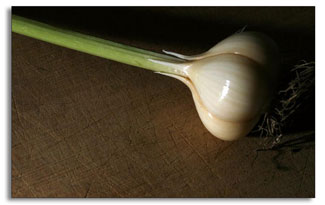|
|
All you need is cloveby Ari LeVaux We planted on borrowed land in the southwest hills of Portland, Ore., and mulched it with maple leaves, most of which blew away in the first winter storm. Luckily, Portland’s climate is mild enough that you don’t need to mulch garlic. We harvested a few hundred pounds, an insane amount of garlic for two single guys. In Portland in the 1990s, moving garlic of this quality was as easy as getting rid of extra pot. Large of clove, rich in flavor and easy to work with, our stuff was the dank. When autumn returned, we reinvested 50 pounds of our harvest into round two. And so on, season after season, in different yards and fields across the West. Eventually my garlic bro and I went separate ways, each with our share of Killarney Red. A few years later, I happened upon some gorgeous heads of Romanian Red garlic for sale at a barter fair in north-central Washington, where the world’s best garlic is grown. I invested in 20 pounds and brought it home to Missoula, where I planted almost every clove. Looking back on that purchase, I feel the way people who bought shares in Apple around the same time must feel.
She had obviously not followed our garlic equation, and that stung. It was bad enough that I was destined to run out of garlic for the first time in decades, but she had bailed on our equation, the one we derived together at a coffee shop in Southwest Colorado. It was the first time for both of us at actually applying our high school algebra skills, as we wrestled together over that formula. Now she’d thrown away that moment like it was old sushi. In practical terms, that meant that after we removed from our meager harvest the correct amount to plant for next year, our stash would be nearly gone. We’d probably have to start paying for our bulb-a-day habit by January. Rather than surrender to this humiliation, I invested again. I spent $180 online on a bunch of different hardneck garlic varieties, including Turkish Red, Pskem, Pennsylvania Dutch, Metechi, Zemo, Russian Red, Russian Inferno, Chinese Red and White, and Vostok. I figured I’d use this garlic shortage as an opportunity to broaden my horizons, and maybe find the next Romanian Red. Most varieties were tasty, but only the Metechi, Pennsylvania Dutch and Chinese Red and White were competitive size-wise, and I’ll be replanting a limited amount of those for variety. But none bested the Romanian Red, size-wise, and it remains my go-to. I planted according to the equation, which calculates how many bulbs from the harvest must be set aside for planting in order to generate a self-sustaining garlic crop. Here, “X” is the number of bulbs you need to plant. To solve for X, you need Y, the average number of cloves per bulb in your garlic. Romanian Red averages five cloves per bulb, so Y=5. And you need to know Z, the number of harvested bulbs you want to eat. In my case, Z=365, or one bulb per day. Plugging in my values, X = 365/(5-1), or 91.25, which I round up to 92. Checking my math: 92 bulbs contain on average 460 cloves, each of which will grow into a bulb. If I harvest 460 bulbs, and subtract the 365 bulbs I intend to eat, I’m left with 95 bulbs for planting next year. The extra three bulbs, a bonus, are the result of rounding up from 91.25. After that brain-cramping mathematical challenge, planting the garlic is the easy part. It’s generally planted in October or November. You want good dirt with plenty of organic material and nitrogen. Carefully break the bulbs into individual cloves, leaving the peel on and trying not to break off the little scabby plate at the bottom of each clove where the root comes out. Plant the cloves with the scabby side down, an inch deep, 6 inches apart. Then, assuming you have harsher winters than Portland’s to contend with, mulch your patch with straw – not hay – about 3 inches deep. Straw doesn’t have seeds, like hay, and won’t blow away as easily as leaves. It will keep your garlic warm in the winter and help the soil hold moisture come spring, when the young garlic will poke through the mulch, at which point it’s off to the races. Water it well. When the leaves start turning brown despite dedicated watering, it’s time to harvest. Entire books have been written on the subject of garlic cultivation, and if you’re serious about investing your time, money and land into a real garlic crop, you might want to consult a more in-depth source. I recommend Growing Great Garlic by Ron Engeland as a great how-to source, and A Garlic Testament by Stanley Crawford for a beautiful look at life in Northern New Mexico through the lens of garlic cultivation. In the meantime, go online or hit the farmers market for some bulbs to plant. Try as many varieties as you can. The more diversity in your trials, the more likely you’ll find your own Romanian Red, the garlic of your dreams that grows well where you live and makes you happy when you eat. |


 My Romanian Red is spectacular in every way. It’s everything I’ve ever wanted in garlic. Great flavor, easy peeling, and it grows large and robust in my climate. I stopped planting the other kind, and I’ve been living on Romanian Red since then. That is, until two years ago, when I didn’t plant enough.
My Romanian Red is spectacular in every way. It’s everything I’ve ever wanted in garlic. Great flavor, easy peeling, and it grows large and robust in my climate. I stopped planting the other kind, and I’ve been living on Romanian Red since then. That is, until two years ago, when I didn’t plant enough.